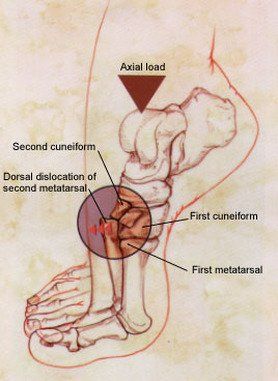The Lisfranc Joint
What is The Lisfranc Joint?
The Lisfranc joint is the point at which the metatarsal bones (long bones that lead up to the toes) and the tarsal bones (bones in the arch) connect. The Lisfranc ligament is a tough band of tissue that joins two of these bones. This is important for maintaining proper alignment and strength of the joint.

Causes
How Do Lisfranc Injuries Occur?
Injuries to the Lisfranc joint most commonly occur in automobile accident victims, military personnel, runners, horseback riders, football players and participants of other contact sports, or something as simple as missing a step on a staircase.
Types of Lisfranc Injuries
There are three types of Lisfranc injuries, which sometimes occur together: sprains, fractures, and dislocations.
Symptoms
The symptoms of a Lisfranc injury may include:
- Swelling.
- Pain in the midfoot.
- Inability to bear weight
- Bruising or blistering on the arch.
- Abnormal widening of the foot.
Diagnosis
Lisfranc injuries are sometimes mistaken for ankle sprains, making the diagnostic process very important. To arrive at a diagnosis, the foot and ankle surgeon will ask questions about how the injury occurred and will examine the foot to determine the severity of the injury.
X-rays and other imaging studies may be necessary to fully evaluate the extent of the injury. The surgeon may also perform an additional examination while the patient is under anaesthesia to further evaluate a fracture or weakening of the joint and surrounding bones.
Non-surgical Treatment
If you are unable to see a foot and ankle surgeon immediately, you should stay off the injured foot, keep it elevated and apply a bag of ice wrapped in a thin towel to the area every 20 minutes of each waking hour. Treatment by the foot and ankle surgeon may also include one or more of the following, depending on the type and severity of the Lisfranc injury:
- Immobilization.
- Oral medications.
- Physical therapy.
When is Surgery Needed?
Lisfranc injuries are sometimes mistaken for ankle sprains, making the diagnostic process very important. To arrive at a diagnosis, the foot and ankle surgeon will ask questions about how the injury occurred and will examine the foot to determine the severity of the injury.
X-rays and other imaging studies may be necessary to fully evaluate the extent of the injury. The surgeon may also perform an additional examination while the patient is under anaesthesia to further evaluate a fracture or weakening of the joint and surrounding bones.
Complete and comprehensive spectrum of both diagnosis and treatments
QUICK LINKS
ABOUT
Specialist Foot and Ankle Surgery and Consultation in Manchester. Our specialist team of surgeons and podiatrists provide the highest level of expertise in the effective management of any foot and ankle condition. .
Manchester Foot And Ankle Clinic / North West OrthoSports is a Registered Trade Mark
North West OrthoSports / Manchester Foot & Ankle Clinic Ltd
93-107 . Lancefield Steet
Glasgow .G3 8HZ
Limited Company-387376
VAT Registration - 214 0705 54
Please See Our Legal Disclaimer on Online Medical Advice
All Rights Reserved | Manchester Foot And Ankle Clinic | Privacy Policy


